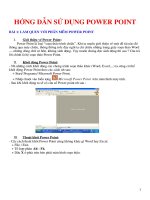FLOATING POINT PRESENTATION
Bạn đang xem bản rút gọn của tài liệu. Xem và tải ngay bản đầy đủ của tài liệu tại đây (277.62 KB, 11 trang )
.c
om
ng
co
an
th
ng
cu
u
du
o
IEEE 754 FLOATING POINT
REPRESENTATION
Alark Joshi
CuuDuongThanCong.com
Slides courtesy of Computer Organization
and Design, 4th edition
/>
Representation for non-integral numbers
In binary
an
th
ng
–2.34 × 1056
+0.002 × 10–4
+987.02 × 109
normalized
not normalized
du
o
co
Like scientific notation
±1.xxxxxxx2 × 2yyyy
u
Including very small and very large numbers
ng
Types float and double in C
cu
.c
om
FLOATING POINT
CuuDuongThanCong.com
/>
.c
om
FLOATING POINT STANDARD
Defined by IEEE Std 754-1985
Developed in response to divergence of
representations
Portability issues for scientific code
an
co
ng
Now almost universally adopted
Two representations
ng
th
du
o
u
Single precision (32-bit)
Double precision (64-bit)
cu
CuuDuongThanCong.com
/>
.c
om
IEEE FLOATING-POINT FORMAT
single: 8 bits
double: 11 bits
single: 23 bits
double: 52 bits
Fraction
co
ng
S Exponent
th
an
x (1)S (1 Fraction) 2(Exponent Bias)
S: sign bit (0 non-negative, 1 negative)
Normalize significand: 1.0 ≤ |significand| < 2.0
cu
u
du
o
ng
Significand is Fraction with the “1.” restored
Always has a leading pre-binary-point 1 bit, so no need to
represent it explicitly (hidden bit)
CuuDuongThanCong.com
/>
.c
om
IEEE FLOATING-POINT FORMAT
single: 8 bits
double: 11 bits
single: 23 bits
double: 52 bits
Fraction
co
ng
S Exponent
du
o
Exponent: excess representation: actual exponent +
Bias
Ensures exponent is unsigned
Single precision: Bias = 127;
Double precision: Bias = 1203
u
cu
ng
th
an
x (1)S (1 Fraction) 2(Exponent Bias)
CuuDuongThanCong.com
/>
Exponents 00000000 and 11111111 are reserved
Largest
co
an
th
ng
Exponent: 00000001
actual exponent = 1 – 127 = –126
Fraction: 000…00 significand = 1.0
±1.0 × 2–126 ≈ ±1.2 × 10–38
du
o
value
ng
Smallest
value
u
exponent: 11111110
actual exponent = 254 – 127 = +127
Fraction: 111…11 significand ≈ 2.0
±2.0 × 2+127 ≈ ±3.4 × 10+38
cu
.c
om
SINGLE-PRECISION RANGE
CuuDuongThanCong.com
/>
Exponents
value
co
Exponent: 00000000001
actual exponent = 1 – 1023 = –1022
Fraction: 000…00 significand = 1.0
±1.0 × 2–1022 ≈ ±2.2 × 10–308
ng
du
o
Largest
value
Exponent: 11111111110
actual exponent = 2046 – 1023 = +1023
Fraction: 111…11 significand ≈ 2.0
±2.0 × 2+1023 ≈ ±1.8 × 10+308
u
cu
th
an
0000…00 and 1111…11 are reserved
ng
Smallest
.c
om
DOUBLE-PRECISION RANGE
CuuDuongThanCong.com
/>
Relative
.c
om
FLOATING-POINT PRECISION
precision
all fraction bits are significant
Single: approx 2–23
th
Equivalent to 52 × log102 ≈ 52 × 0.3 ≈ 16
decimal digits of precision
u
du
o
Double: approx 2–52
cu
Equivalent to 23 × log102 ≈ 23 × 0.3 ≈ 6
decimal digits of precision
ng
an
co
ng
CuuDuongThanCong.com
/>
Represent –0.75
–0.75 = (–1)1 × 1.12 × 2–1
an
th
ng
S=1
Fraction = 1000…002
Exponent = 1 + Bias
du
o
co
= -1 ì 1. ẵ ì ẵ
= -1.5 * .5 = -0.75
ng
.c
om
FLOATING-POINT EXAMPLE
Single: –1 + 127 = 126 = 011111102
Double: –1 + 1023 = 1022 = 011111111102
cu
u
Single: 1011111101000…00
Double: 1011111111101000…00
CuuDuongThanCong.com
/>
What number is represented by the singleprecision float
11000000101000…00
co
ng
.c
om
FLOATING-POINT EXAMPLE
S=1
Fraction = 01000…002
Exponent = 100000012 = 129
ng
th
an
du
o
x = (–1)1 × (1 + 012) × 2(129 – 127)
u
= (–1) × 1.25 × 22
= –5.0
cu
CuuDuongThanCong.com
/>
.c
om
EXAMPLE
Number to IEEE 754 conversion
/>
an
co
ng
Check IEEE 754 representation for
du
o
ng
th
127.0 – 0 10000101 11111100000000000000000
128.0 – 0 10000110 00000000000000000000000
2.0, -2.0
127.99
127.99999 (five 9’s)
What happens with 127.999999 (six 9’s) and 3.999999 (six 9’s)
u
cu
CuuDuongThanCong.com
/>









